#carcharodontosaurus fossils
Explore tagged Tumblr posts
Text
Your Ultimate Guide to Collecting Carcharodontosaurus Fossils

Carcharodontosaurus fossils have become highly treasured among fossil collectors. From razor-sharp teeth to towering vertebrae, fossils belonging to these giant predators provide a peek into an era when carcharodontosaurs walked the Cretaceous landscapes of Africa. In this guide we’ll dive deep into the details of this giant carnivorous dinosaur so you have a better understanding about these beautiful creatures from the past. Read more: https://fossilageminerals.hashnode.dev/your-ultimate-guide-to-collecting-carcharodontosaurus-fossils
0 notes
Text
daily vivosaur 71
Genus: carcharodontosaurus
a dinosaur with jagged teeth and a powerful bite, as it ranks up it learns a rotation skill it can use to ruin enemy strategies, its team skill deals damage to all opponents

#my art#paleoart#paleo art#dinosaur#fossil fighters#carcharodontosaurus#3d art#low poly#low poly art#blockbench
31 notes
·
View notes
Text
[ Carchar ]
" With enough parts integrated, Carchar can excite an enemy, then pound it with Carchar Fury for an effective combo. "
140 notes
·
View notes
Text
sometimes i wake up and i remember that I LOVE DINOSAURS !!!!!! RAAAAGHHHH !!!!!!! anyways anyone else ever think about the kem kem beds. because i do.
kem kem beds save me. save me kem kem beds. the disproportionate split between large herbivores and megatheropods enamors me. what do you mean theres just only sauropods and no other large herbivores. what do you mean theres like 20 different large theropod species running around at the same time. why are there fish that damn BIG. what even are noasaurids. also spinosaurus is here.
kem kem group so fine kem kem group divine. my roman empire is thinking about how the ecosystem of the kem kem beds was so incredibly diverse that it allowed for all of these different VERY LARGE carnivores to coexist because they all occupied different niches in the environment. which just totally crumbles the stereotype of Big Theropod Deathmatch because uh yeah, sorry jw bros, we have proof of some of the largest theropods in history all living in the same place at the same time!!! successfully!!! animals do not just go around beefing and fighting one another 24/7, especially carnivores. carcharodontosaurus and spinosaurus are not fistfighting everytime they see one another. spinosaurus is busy sleeping like a log on the riverbank and carchar is just coming by to get a drink. carchar accidentally steps on spino's tail and the spino snaps at it but misses completely because its half asleep and stupid. carchar walks away. they are just animals !!! and every ecosystem is incredibly complex and i love that even though we only have fossils and rocks to go off of this fact is SO evident across the globe but kem kem beds is so special to me. in my heart. anyways very rough sketch to go along with this train of thought.
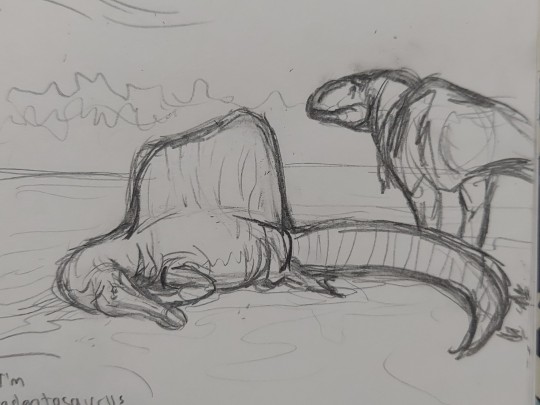
i miss you kem kem beds. sighs dreamily
#dinosaur#dinosaurs#paleontology#paleoblr#fossils#spinosaurus#carcharodontosaurus#sigh#i miss u kem kem group .... every day#dinosaurs being treated like any other animal ... something i savor more than anything#rodtalks
102 notes
·
View notes
Text

A dinosaur tooth of an indeterminate carcharodontosaurid, possibly cf Carcharodontosaurus sp. from the Kem Kem Group in Taouz, Morocco. It's unclear what the tooth morphology of Sauroniops pachytholus is to know for sure if it can be distinguished from Carcharodontosaurus saharicus. While Sauroniops may not be diagnostic down to the genus level, and thus a nomen dubium, it is at the very least typically found as a basal carcharodontosaurid similar to the older Eocarcharia dinops. Thus, it is likely that these more derived carcharodontosaurid teeth belong to Carcharodontosaurus and the more basal Acrocanthosaurus-like teeth belong to Sauroniops. But it is entirely possible that there are additional taxon. Ironically, despite the name, Carcharodontosaurus does not actually possess shark-like teeth like the destroyed Egyptian specimen now referred to as Tameryraptor markgrafi. While Ernst Stromer likely intended the name Carcharodontosaurus for Tameryraptor, due to the weird rules of taxonomy, the name goes to the Moroccan neotype being closer to the Algerian Megalosaurus saharicus tooth taxon than to Tameryraptor.
#dinosaur#fossils#paleontology#palaeontology#paleo#palaeo#carcharodontosaurus#sauroniops#carcharodontosauridae#theropod#cretaceous#mesozoic#prehistoric#science#paleoblr#fossil friday#fossilfriday#カルカロドントサウルス#カルカロドントサウルス科#サウロニオプス#恐竜#化石#古生物学
10 notes
·
View notes
Text
Monday Musings: Who hunted Sauropods?
With the immense size of most sauropods it is hard to imagine what might have been brave enough (or stupid enough) to take one on. It seems unlikely but theropod tooth marks have been found on sauropod bones so we know they were being eaten at the very least.
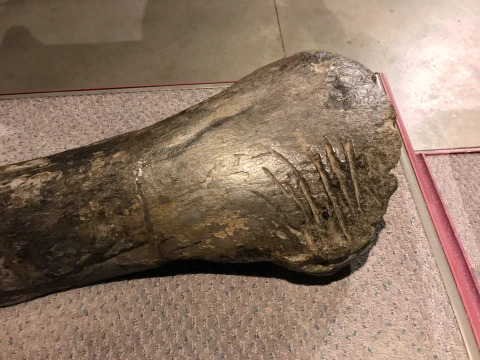
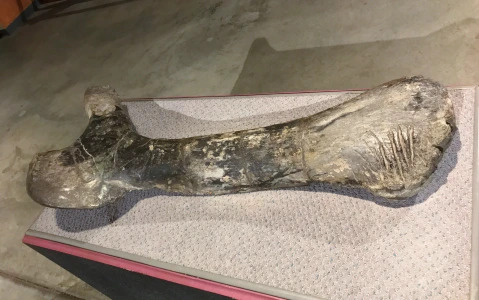
Mmm, Apatosaurus ischium.
Allosaurus is probably the most well-known of the sauropod predators. Often found alongside sauropod remains, it is highly likely that it hunted juveniles or sick adults in packs. One hypothesis for its hunting strategy is that it would use its head somewhat like an axe.

It had a relatively weak bite force but incredibly strong neck muscles. Its skull could withstand forces almost 15x that of its bite. They were also fast sprinters so they could ambush their prey. They would run up, use their massive, recurved claws on their hands as hooks to grapple prey much like raptors (meaning birds of prey, actual raptors) and then use their jaws to rake flesh off the sauropod causing it to bleed out. This allowed Allosaurus to follow behind at a safe distance while its prey bled to death.


Allosaurus vs Barosaurus
It is likely that cousins of Allosaurus such as Carcharodontosaurus, Giganotosaurus, and Mapusaurus also hunted sauropods in packs. All of these carnosaurs lived in sauropod heavy environments and had similar body plans that would allow them to hunt in similar fashions.
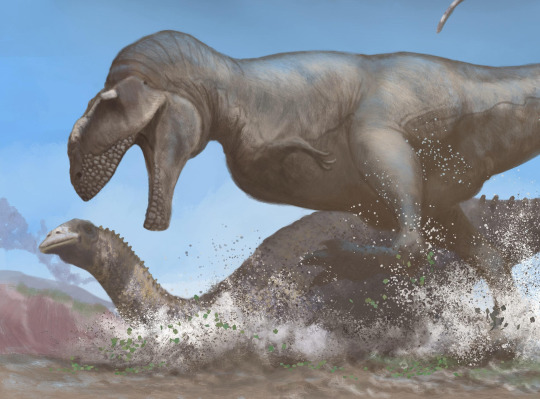
Carcharodontosaurus vs Rebbachisaurus by Mark Witton
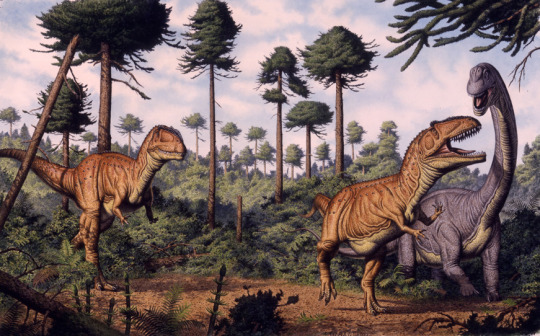
Giganotosaurus and Sauropod by Bob Walters and Tess Kissinger

Mapusaurus vs sauropods
It has also been suggested that abelisaurids like Majungasaurus were specialized for hunting sauropods. With short, broad snouts they might have hunted like modern felids: bite and hold on.

Majungasaurus tooth marks have been found on Rapetosaurus bones so we know they were eating sauropods at the very least.
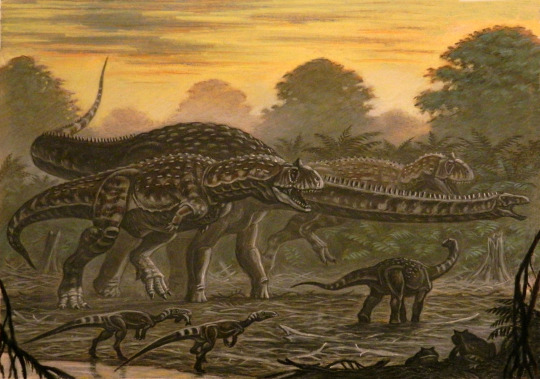
#paleontology#fossils#dinosaur#fun facts#allosaurus#sauropod#carcharodontosaurus#giganotosaurus#theropod#bite force#predator#prehistoric
42 notes
·
View notes
Text

Carcharodontosaurus teeth
21 notes
·
View notes
Photo

Carcharodontosaurus Dinosaur Tooth Fossil (Similar to T-Rex) - Cretaceous, Kem Kem Beds, Morocco - 100% Genuine, COA
This authentic Carcharodontosaurus Dinosaur Tooth Fossil is a magnificent specimen from the Aptian stage of the Cretaceous period, sourced from the Kem Kem Beds in the Tegana Formation, Kem Kem Basin, Morocco. Carcharodontosaurus, often likened to the T-Rex due to its colossal size and predatory nature, was one of the largest carnivorous dinosaurs, with serrated teeth designed for tearing through the flesh of other large dinosaurs.
Dating back roughly 100 million years, this tooth fossil offers a unique glimpse into the life of this apex predator that dominated the North African landscape. Its well-preserved structure, complete with visible serrations and natural colorations, makes this fossil a prized piece for collectors and enthusiasts alike.
Key Features:
Species: Carcharodontosaurus (Large Theropod Dinosaur, similar to T-Rex)
Location: Kem Kem Beds, Tegana Formation, Kem Kem Basin, Morocco
Age: Aptian, Cretaceous Period (~100 million years old)
Size: Full dimensions provided in the photos (scale cube = 1cm)
100% Genuine: Comes with a Certificate of Authenticity
Actual Specimen: The photos show the exact fossil you will receive
This is a carefully selected, genuine specimen of a fierce dinosaur from the Cretaceous period, perfect for display or as a treasured addition to any fossil collection. Own a piece of prehistoric history with this extraordinary Carcharodontosaurus tooth fossil!
#Fossil#Tooth#T rex#Carcharodontosaurus#Saharicus#Theropod#Dinosaur#Cretaceous#Ancient#Prehistoric#Teeth#Fossilized
5 notes
·
View notes
Text
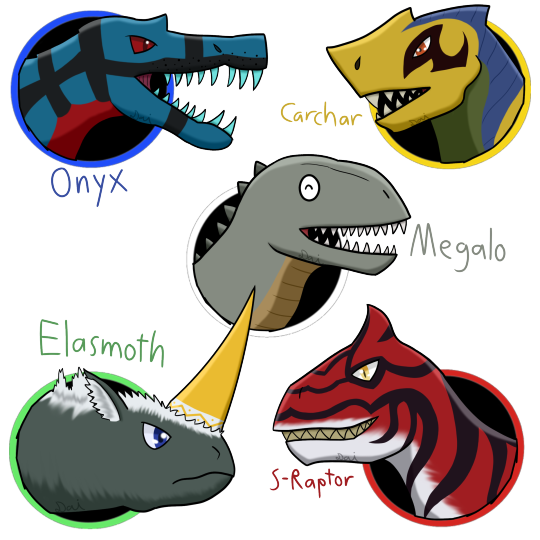
Fossil Fighters posting! Just a doodle featuring my favourite vivosaurs of each attribute: Onyx (Baryonyx) for Water, Carchar (Carcharadontosaurus) for Earth, Megalo (Megalosaurus) for Neutral, Elasmoth (Elasmotherium) for Air, and S-Raptor (Sinraptor) for Fire.
#fossil fighters#vivosaur#baryonyx#carcharodontosaurus#megalosaurus#elasmotherium#sinraptor#doodle#dinosaur#dinosaur art#prehistoric mammals#woolly rhinoceros#woolly unicorn#artisits on tumblr#paleoart#prehistoric
45 notes
·
View notes
Text
Jurassic June day 29: Carchar!

"She's not a shark, she just really really wants to be a shark. Thus is the result from watching too many baby shark videos as a child."
Genus: Carcharodontosaurus
Time: Late Cretaceous, 99-94 mya
Discovered: Egypt
Length: 12.5m (41 ft)
Diet: Carnivore
Tyrant of the dunes! I'm happy with how this one came out. Only one more day left to go, I'm tired :'D
#fossil fighters#fossilfighters#vivosaur#dinosaurs#fossil fighters fanart#theropod#carcharodontosaurus
52 notes
·
View notes
Text

Ancient Predator: Carcharodontosaurus Fossil in Charcoal
1 note
·
View note
Text
youtube
New #Palaeontology short on the discovery of the new carcharodontosaurid #Tameryraptor is now available to watch.
#dinosaur#dinosaurus#prehistoriclife#prehistoric#cretaceous#cenomanian#fossil#carcharodontosaurus#tameryraptor#carcharodontosaurids#therapod#eygpt#morroco#bahariya#oasis#africa#planetdinosaur#Youtube
0 notes
Text
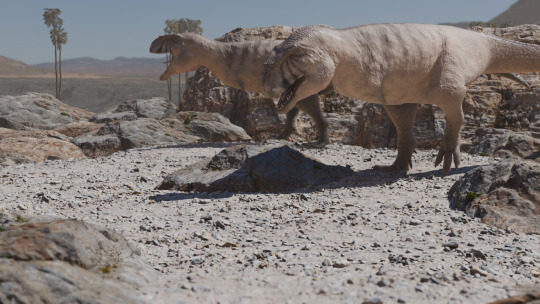
A groggy pair of the currently undescribed/named giant Kenyan abelisaurids wake up on a hot afternoon to find a more shaded spot to nap. To be honest I think it's a bit odd how this thing was found several years ago and still has not been properly described, considering it is not only a giant theropod but the largest? of its respective group. You would think they would jump all over describing the next "bigger than t. rex". Then again, I do not know how the process works, and I assume properly describing a species involves a lot of collaboration/review with different paleontologists and other bureaucratic-esque things that take forever.
An odd thing about abelisaurids is how they are found in basically every cretaceous/south american fossil bed. if there's a new dinosaur from one of these beds it is either a weirdly small sauropod, a bird thing, or an abelisaurid.
i based the reconstruction off of Rajasaurus, albeit with added bulk, as its skull is relatively similar to the Titanovenator reconstruction. The little twin snout horns are speculative and meant to be more like the bigger scales on an iguana's face than proper horns. To be honest I hope they give this thing a cool African name or name it after some kind of monster or god as Titanovenator is just a little eh. With big meat-eating dinosaurs the names can get a little too edgy sometimes (cough cough Tyrannotitan). The perfect name in my opinion is Carcharodontosaurus, as it sounds formidable without any basis in pop culture or being obviously and overly edgy.

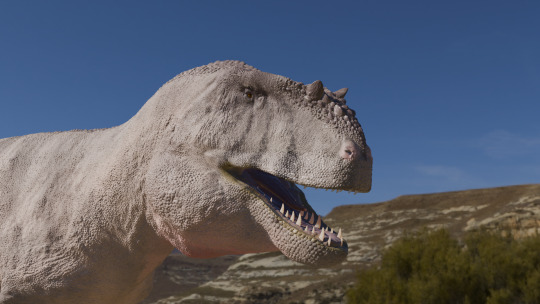
#dinosaur#render#blender#abelisaur#abelisaurid#abelisaurids#creaturedesign#prehistoricanimals#theropod#creatureconcept#prehistoriccreatures#theropoddinosaurs#prehistoricplanet#theropoddinosaur#theropod_dinosaur#dinosaursandprehistoricanimals#theropodcretaceous#titanovenator
10 notes
·
View notes
Text
file : interesting creatures (#3): tameryraptor markgrafi
lowercase intended
the tameryraptor markgrafi is a predatory dinosaur species that was discovered in early April of 1914, but was utterly, entirely misclassified as a previously discovered member of the carcharodontisauridae family for just shy of 111 years. (discovered in 1756, the carcha family was originally named the megalosaurus saharicus, and the name was changed in 1831 by a man named ernst stromer.)
what was thought to be the carcharodontosaur specimen was discovered in 1914, in the bahariya formation from a locality found in the northern section of egypt's bahariya oasis. the specimen took many years to arrive in germany, where it was placed on display in a museum. due to political tension during world war ii between the german empire and egypt, which was then owned by britain, the specimen was destroyed.
on january 14th, 2025, it was released that this specimen had actually come from the tameryraptor markgrafi, essentially a different family of dinosaurs. before the specimen was destroyed it contained skull fragments, three cervical and one caudal vertebrae, a manual ungual, the left fibula, both of the dinosaur's femora, teeth, and pieces of ischium and pubis bones. an endocast of the braincase, which reportedly survived can also be located in berlin.
images taken of the fossils before they were destroyed showed that there was a significant difference between what we recently found to be the tameryraptor and more recent carcharodontosaurus specimens found in morocco, for example. this means that stromer's classification was incorrect, and has now been reclassified as a predatory raptor species, although this may change as studies continue. dr. oliver rauhut, senior author of the study, stated that the tameryraptor markgrafi was close to 33 feet long, had a prominent nasal horn similar to the ceratosaurus, and had nearly perfectly symmetrical teeth, unlike most carcharodontosauridae discovered. the tameryraptor has been foted to north african and south americasian group of dinosaurs called the metriocanthosaurs.
the dinosaur family's generic name, tameryraptor, combines an informal name meaning "beloved land" that the ancient egyptians gave their country (ta-mery), and the latin word "raptor," which means thief. the specific name, markgrafi, is simply an instance of humankind so commonly naming shit after themselves. the tameryraptor markgrafi is currently classified as a smaller, more recently discovered member of the carcharodontosaurid family.
(researcher rhykar asked me to include this screenshot in this particular file.)

sources
the dominating source i'd like to give credit to for the information in this post is rhykar, my lovely nerdy professional ghost hunting boyfriend, fellow owner and creator and primary organization person of this account!
nypost
wikipedia
author's note: since this dinosaur family has only recently become its own species, there isn't a lot of information available about it. this file will be updated as more information comes out/is verified.
send an ask if you want more info, or if you've got more to share! please use this post as a source if you post or use information you found on it!
#+ file : creatures#+ subfile : dinosaurs - spinosaurus#+ researcher : hayle#dinosaurs#tameryraptor#tameryraptor markgrafi#fun facts#jurassic park#jurassic park inaccuracies#africa#african dinosaurs#prehistory#prehistoric creatures#tameryraptor facts#dinosaur facts#egyptian dinosaurs#egyptian paleontology
4 notes
·
View notes
Text

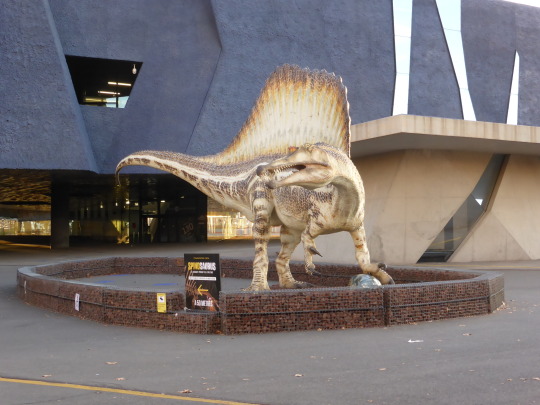

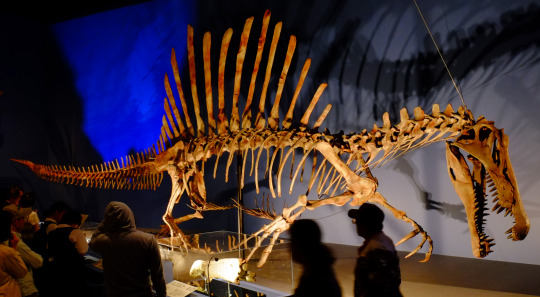
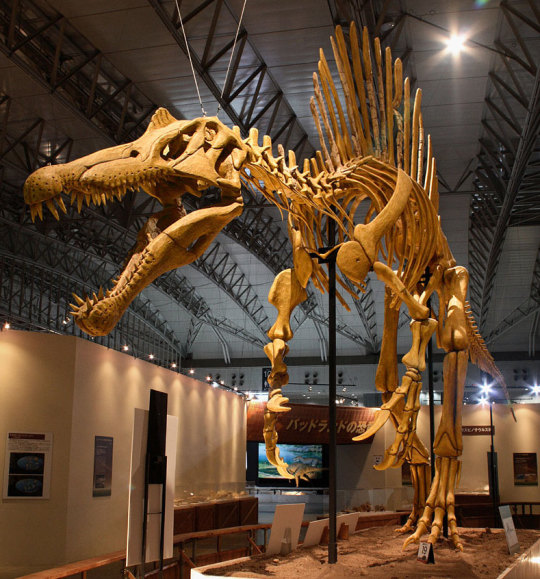
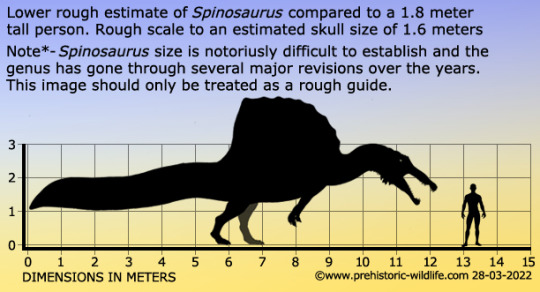
Spinosaurus
(temporal range: 99-93.5 mio. years ago)
[text from the Wikipedia article, see also link above]
Spinosaurus (/ˌspaɪnəˈsɔːrəs/; lit. 'spine lizard') is a genus of spinosaurid dinosaur that lived in what now is North Africa during the Cenomanian to upper Turonian stages of the Late Cretaceous period, about 99 to 93.5 million years ago.[2][3] The genus was known first from Egyptian remains discovered in 1912 and described by German palaeontologist Ernst Stromer in 1915. The original remains were destroyed in World War II, but additional material came to light in the early 21st century. It is unclear whether one or two species are represented in the fossils reported in the scientific literature. The best known species is S. aegyptiacus from Egypt, although a potential second species, S. maroccanus, has been recovered from Morocco. The contemporary spinosaurid genus Sigilmassasaurus has also been synonymized by some authors with S. aegyptiacus, though other researchers propose it to be a distinct taxon. Another possible junior synonym is Oxalaia from the Alcântara Formation in Brazil.
Spinosaurus is the longest known terrestrial carnivore; other large carnivores comparable to Spinosaurus include theropods such as Tyrannosaurus, Giganotosaurus and Carcharodontosaurus. The most recent study suggests that previous body size estimates are overestimated, and that S. aegyptiacus reached 14 metres (46 ft) in length and 7.4 metric tons (8.2 short tons) in body mass.[4] The skull of Spinosaurus was long, low, and narrow, similar to that of a modern crocodilian, and bore straight conical teeth with no serrations. It would have had large, robust forelimbs bearing three-fingered hands, with an enlarged claw on the first digit. The distinctive neural spines of Spinosaurus, which were long extensions of the vertebrae (or backbones), grew to at least 1.65 meters (5.4 ft) long and were likely to have had skin connecting them, forming a sail-like structure, although some authors have suggested that the spines were covered in fat and formed a hump.[5] The hip bones of Spinosaurus were reduced, and the legs were very short in proportion to the body. Its long and narrow tail was deepened by tall, thin neural spines and elongated chevrons, forming a flexible fin or paddle-like structure.
Spinosaurus is known to have eaten fish, and most scientists believe that it hunted both terrestrial and aquatic prey. Evidence suggests that it was semiaquatic; how capable it was of swimming has been strongly contested. Spinosaurus's leg bones had osteosclerosis (high bone density), allowing for better buoyancy control. Multiple functions have been put forward for the dorsal sail, including thermoregulation and display; either to intimidate rivals or attract mates. It lived in a humid environment of tidal flats and mangrove forests alongside many other dinosaurs, as well as fish, crocodylomorphs, lizards, turtles, pterosaurs, and plesiosaurs.
9 notes
·
View notes
Text
I was getting supplies for weekly incentive for work, but had a wonderful find. This is a big-ticket item for me personally out of Age of the Primes



G2 Grimlock, leader of the original Dinobots
Grimlock transforms into a scientifically inaccurate Tyrannosaurus*
The creation of the Dinobots, in the G1 cartoon, was inspired by first accidental exposure of a fossil near the Ark, then a field trip to a museum. Seeing the power of prehistoric life, the Autobots built a batch of three Transformers based on ancient life. Later, two more were created, and the Dinobots team was formed. Grimlock, being the strongest of the set, became their leader. He played a notable role in the '86 movie, being a main character with decent screen time despite not being a new toy.
He has some traits that could line up nicely with the Decepticons. He despises weakness, valuing strength above almost everything else. And, he isn't that bright, compared to other Transformers. But when it comes down to it, Grimlock despises one thing above weakness: abuse of power. Ultimately, he reluctantly works with the Autobots to ensure that those with power use it appropriately.
He (and the other original Dinobots) has a sort of speech impediment, always referring to himself in third-person as "me Grimlock"
"Me Grimlock no like you!"
"Me Grimlock need new strategy..."
"Me Grimlock not kisser, me Grimlock king!"
This figure also came with a non-transforming, barely posable figure of Autobot Wheelie, but that sucks so I'm not including it.
*if we want to get technical, Grimlock's beast mode has three fingers, meaning it can't be a Tyrannosaurus. However, it can be reasoned that his beast mode is simply based on a Tyrannosaurus, even if it isn't strictly one. If we want to be a stickler, likely candidates for his beast mode are Allosaurus, Carcharodontosaurus, Megalosaurus, or really any large theropod with three fingers. He also has a backward pointing rear claw on his feet that doesn't match up.
1 note
·
View note